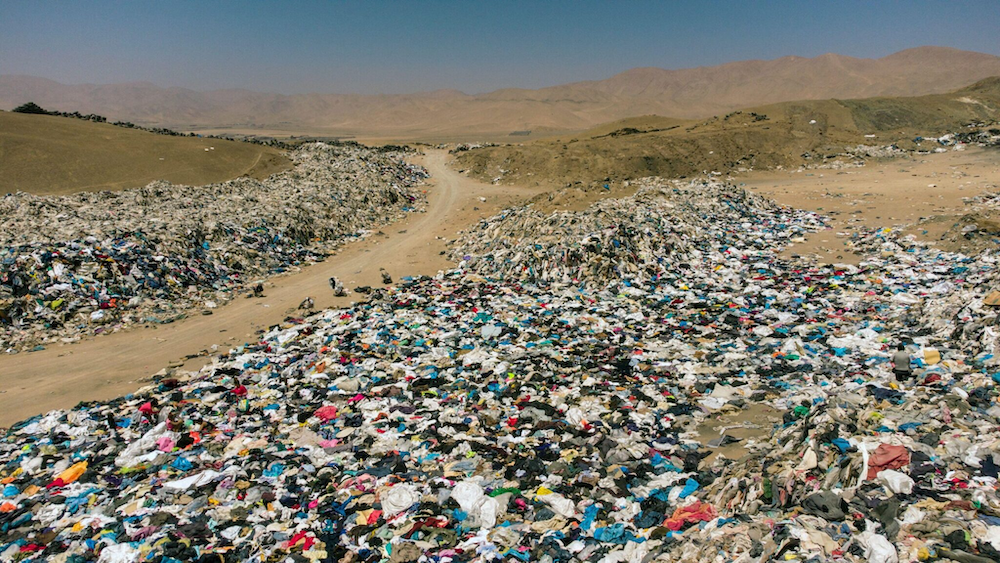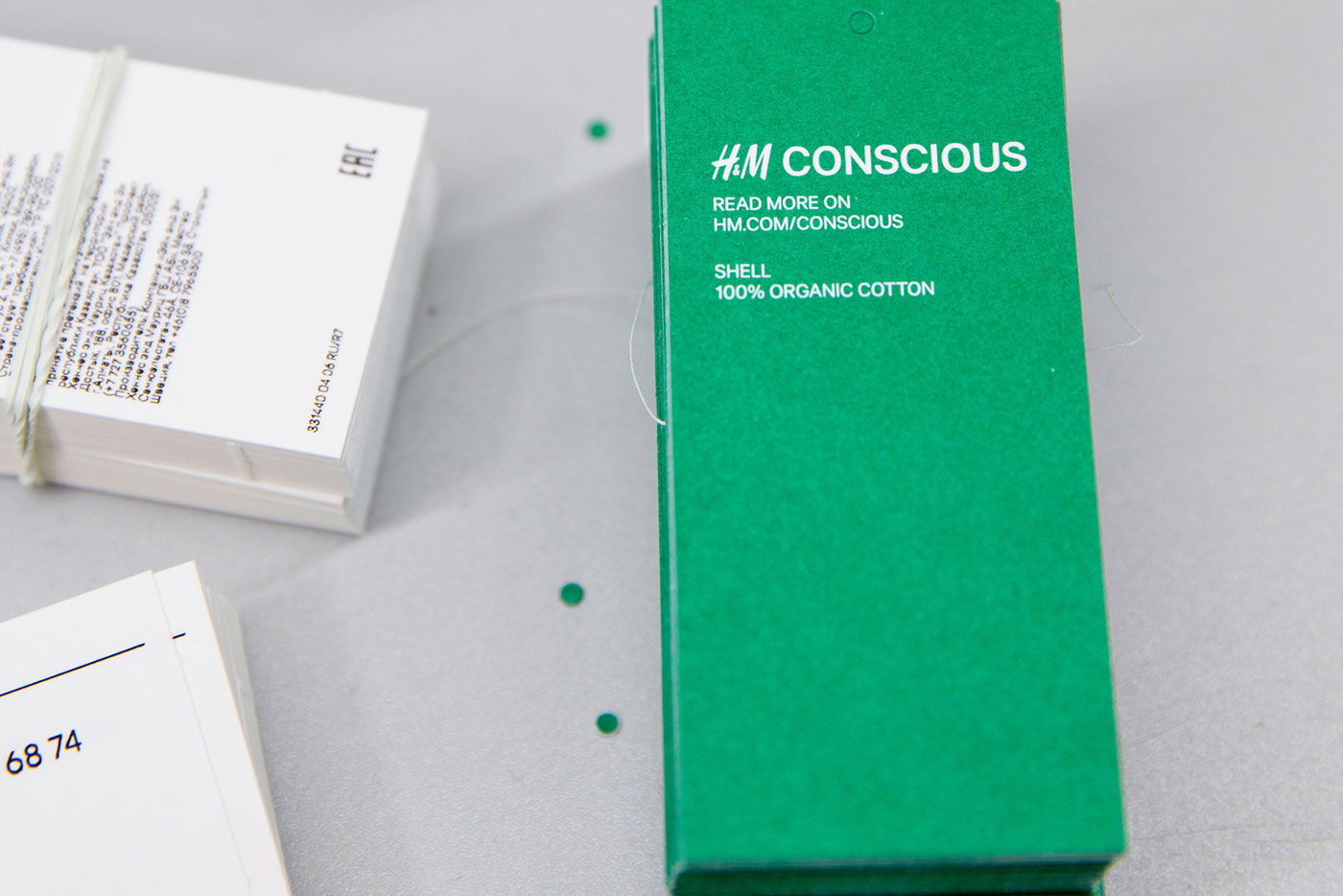YOAN VALAT / EPA/MAXPPP
Last October, anExtinction Rebellion activist burst into a Paris Fashion Week show with a poster reading “Overconsumption = extinction”. The operation denounces the impact of the fashion industry, which produces 8 to 10% of the world’s CO2 emissions per year, on climate change. Despite the dramatic ecological and ethical situation, many of us still buy fast-fashion clothes . Why is it so hard to give up this habit?
” Once you see how difficult it is to make clothes, and how much time and effort it takes, you understand that it’s just not possible for a t-shirt to cost just 5 euros. ”
Wanda Wollinksy, 31, is a German fashion designer and co-founder of the eco-responsible Kasia Kucharska brand.
Kasia Kucharska
. Before studying at the Berlin University of the Arts, she used to buy a lot of fast-fashion clothes . because it’s cheap, and when you’re young you don’t have much money “. She explains that at the start of her course, it was a way of defending the democratization of access to fashion. Today, on the strength of her experience, she is no longer as convinced by this argument and only buys second-hand clothes.
The sheer quantity of clothes that ephemeral fashion represents is what puts the young woman off the most.
“Most of these garments are not biodegradable. It’s alarming to think that they’ll continue to exist even after my death.“she remarks.
Brand co-founders, from left to right, Reiner Törner, Wanda Wollinsky and Kasia Kucharska. Laura Schaeffer
The paradox of fast fashion
Yet fast fashion is a hit, even when its practices run counter to consumers’ ecological convictions. Although climate change is a major concern around the world, sales of disposable clothing have grown at an alarming rate. a spectacular rise in recent years. Between 2000 and 2014, global clothing production doubled. At the same time, the number of times a garment is worn has dropped considerably.
What explains this paradox? Expert Valérie Guillard says it’s because “. buying is rewarding “. Professor of marketing at Paris-Dauphine University, and author of, among other works, the book entitled “
Du gaspillage à la sobriété: Avoir moins et vivre mieux?”
(De Boeck Ed. 2019), her research focuses on consumer psychology and practices.
” When you buy something, it’s a pleasure. Especially when it comes to clothes, you think you’re going to look better, you’re going to have something new to show off. And when you can consume something, it means you’re in touch with society, which values consumption. What’s more, fast fashion isn’t expensive, so many social categories can enjoy it. To renounce this is to renounce a certain way of being in relation to society. ”
Valérie Guillard points out that it takes a long time to change a habit. The identity of the clothes makes the task even more difficult:
”
Clothing is an identity, it’s the exposure of oneself to others, and the gaze of others counts for a lot – it’s normal, we’re in society.
“.
In this context, giving up this consumption habit can feel like deprivation.
The accessibility of fast fashion is also a factor. In fact, for Kartik Chawla, a 27-year-old PhD candidate, this is the main asset of this segment of the clothing industry: he visits H&M or Zara about every 3 months. The young man says he only buys new clothes according to his seasonal needs. However, he explains that going to the thrift store is not a practical alternative, as he doesn’t have much energy to devote to shopping due to his professional occupation:
“I’ve tried buying second-hand clothes, but it takes additional time and effort to find the right garment and make sure it fits well. You may not find what you’re looking for in the first store, so you have to go to the next, and so on… You have to go clothes-hunting.“

Kartik Chawla, 27 years old
Consuming a fast fashion brand is then more a question of convenience. Kartik says it’s willing to pay a little more for eco-responsible and ethical clothing.
”
If I knew of such a brand close to home that matched my style preferences – a style that represents you, that’s important – I’d go there rather than go to Zara
“he says.
Micro-trends and social networks: the infernal duo
In fast fashion, the key word is
fast –
i.e. the speed at which new garments are produced and brought to market. While high-end brands release two collections a year (autumn and spring), fast-fashion companies such as Zara offer new styles and trends until the end of the year. twice a week. In the case of Chinese online fashion retailer Shein, the design and production period is sometimes as short as 3 days only! As a result, consumers are encouraged to buy regularly for fear of running out. And clothes are so cheap that you can easily justify an impulse purchase and feel like you’re saving money.

The breakneck speed of disposable fashion had an impact on the way the Kasia Kucharska brand approached its own work rhythm at the start of their adventure. Wanda denounces self-imposed pressure:
“This We’ve been working on our clothes for about two years now, and even though most people haven’t even seen our designs yet, we feel that what we’re doing is already old hat, and that we have to come up with something new every six months for fear of being forgotten. “.
Faced with this insane pace, she defends slow fashion and its more thoughtful practices that respect the production chain.

Kasia Kucharska brand underwear made entirely of latex and biodegradable Sandra Gramm
The phenomenon of micro-trends is accelerated by social networks. Today, more than half of all posts on Instagram are dedicated to fashion or beauty. Fast fashion brands are moving away from traditional advertising to more subtle, targeted marketing with the help of influencers. Through videos of
haul
“As shown in the Arte documentary, content creators are building a more “authentic” relationship with users, Fast Fashion – Les dessous de la mode à bas prix.
Marie Cherasse, a 26-year-old Frenchwoman, says she limits herself to necessary purchases, but recognizes that social networks act as an external pressure “without us even realizing it.
without realizing it
“. She recalls, for example, the fashion for top Bardot :
“I saw it constantly on social networks, and seeing it worn, I found it beautiful. I found myself wanting to buy it in the store“.
In the end, she decided not to go ahead with the purchase. The ecological footprint
despicable
The “despicable” and poor working conditions behind the manufacture of these fast-fashion garments motivated her approach, and today she has banned herself from going into stores such as Mango or Stradivarius.
” Ct’s unbearable to think that just for wearing a t-shirt to a party, there are people who will suffer serious health problems or die of cancer at the age of 23. “she remarks, before adding: ” I try to buy less at all “.
Marie Cherasse, doctoral student in condensed matter physics, wearing clothes from the eco-responsible Salut Beauté brand.
That’s why when Marie was contacted by eco-friendly brand Salut Beauté to be their ambassador on Instagram, she hesitated before accepting. She absolutely didn’t want to incite consumption, but in the end she decided that promoting a brand that uses recycled fabrics and has a marketing strategy based on feminism is a way of highlighting alternatives that can make those around her think about the way they consume.
Fashion designer Wanda Wollinsky can’t help but notice the power of social networks for her slow fashion brand. Their
Instagram page
is their main form of communication outside their website and can be a formidable marketing tool:
” When someone with a big platform posts a photo of our clothes and links us, we suddenly get 200 new followers and sometimes a few sales. We also enjoy “.
Kasia Kucharska’s Insatgram page
Expert Valérie Guillard notes that you need to be discerning about social networks, which can be very intrusive and addictive. For her, it’s a definitive way of escaping solicitations and simply not being there. However, she qualifies her statement by saying that “.
it’s not all doom and gloom
“on social networks.
” It’s also a great place to find help and advice. For example, if you’re starting out on a zero-waste journey, it’s great to be able to join a community of like-minded people who can help you change your practices. We need role models and support “she stresses.
Consumer frenzy: what to do?
Piles of discarded clothes in Chile’s Atacama desert © MARTIN BERNETTI / AFP / Getty Images
Last November, startling images appeared in the media, revealing mountains of used textiles stretching as far as the eye could see
in the Chilean desert
. This type of open-air landfill, which can also be found in Ghana, India and Côte d’Ivoire, appears in our news feed on a more or less regular basis.
In 2013, it was the collapse of Rana Plaza, which housed several textile garment workshops and caused the death of at least 1,138 people, that left its mark on people’s minds.
There is no shortage of images and events demonstrating a certain consumerist frenzy and its catastrophic consequences. It’s hard to talk about an information deficit when it comes to fast fashion. ” But is the information conscious? “asks Valérie Guillard. She explains that we need to step back and understand where we stand in relation to this issue.
Some deplore
greenwashing
and the confusion it can cause. Kartik Chawla is wary, for example, of clothing labels indicating sustainable production or 100% recycled materials:
“Sometimes I go back and try to verify this data, but it’s an extra effort. There may be a lot going on in the background that you’re simply not aware of.“.
© H&M
Marie Cherasse says she has adopted a self-imposed approach in which she systematically checks whether a garment is eco-responsible:
” It’s a bit heavy on the brain when you’re exposed to attractive offers every day and there’s a craving awakening in your mind. When I see that the garment doesn’t match my criteria, it can sometimes be a bit depressing. “.
Professor Valérie Guillard believes, however, that being consistent with one’s values can lead to a sense of well-being.
”
As long as we’ve integrated the values of sobriety, we’re shifting the norm, and that can bring us real satisfaction
“she notes.
Buying less but better could therefore be a solution, but the expert warns of the dangers of a discourse that excludes certain social categories, and points out that it is important to distinguish between “ those with purchasing power who can substitute quality for quantity, and those who can’t”.
Wanda, for her part, reminds us that the quest for style can continue to be an enjoyable experience for consumers, and that thrift stores and second-hand stores can be made her new mantra. “
Fashion is fun!
“ she exclaims.
If you’d like to find out more about this and other topics, the La Mèche social network contains a media library with a wide range of resources to help you find answers to your questions, practical solutions and ideas for adapting your lifestyle and practices to today’s challenges. A wide range of subjects are covered, including fashion, food, home, business and much more.








